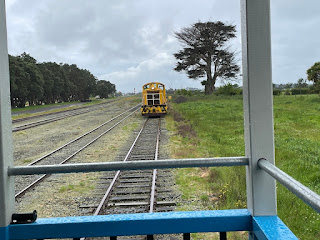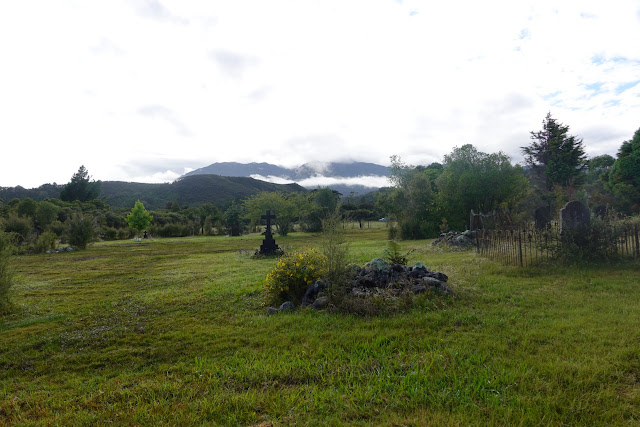Martin BURKE was my great-great-grandfather, who was
born in Co Mayo, Ireland. His family moved to Perth in Scotland when he was a
child, around the time of the Great Famine in Ireland.
Not much is known
about Martin before his marriage to Ann Philp, on the second of February 1861,
in St John’s Catholic Church, Perth, Scotland. He was aged 19 at the time, and
his usual residence was given as Perth. His parents were named as Michael
Burke, labourer, and Bridget Burke, whose maiden name was listed as Flinn. His
wife Ann gave her usual residence as Abernethy, and she was aged 21.
 |
| Image from Family Search microfilm back in the days of their microfilms! |
Shortly after their
marriage, the census was taken for Scotland, on 7 April 1861. On this night, Martin
was with his Burke family in a house at 134 High Street, Perth, Scotland. (At
least one other family shared the house with them.) Martin was described as
married, aged 19, and a ploughman. There were five other family members listed
at the address on census night- his parents Michael (52) and Bridget (49); his unmarried
brothers Thomas (20), a ploughman, and John (16), a cabinet maker apprentice;
and his sister Mary (9). At the date of this census, his wife Ann appears to be
with her father in Balvaird Cot House in Abernethy, as a housekeeper.
In the census, the Burke
family all had their birthplaces described as “Ireland”, except for Mary, who
was born in “Perthshire, Perth.” Mary was aged 9, so must have been born around
1851/52. If John was born in Ireland some 7 years earlier than this, around 1844/45,
the family presumably left Ireland sometime between 1845 and 1851, during the
Famine. Maggie Gaffney, a third cousin and fellow Burke descendant, has done
extensive research in the baptismal/marriage records in Perth, and has
discovered that several related Burke/Flynn families also came to Perth.
We haven’t found a
baptism for Martin Burke. In the census, his birthplace was just listed as
Ireland, though his death registration in New Zealand says he was from Co Mayo.
Maggie Gaffney discovered the likely townland/parish origin of
the Burke/Flynn family and eventually found they were from Derrycraugh
(Derrycraff) in the RC Parish of Aghagower. The location was finally confirmed
when an 1844 baptism record was found for John Burke, Martin’s brother. (Maggie has a record of this from rootsireland.ie, though a transcript can also
be found on FindMyPast.)
In 1862, Martin and
Ann’s first child, Mary Burke, was born on 21 August at Polgavie Cottar’s
Houses, in the Parish of Inchture in the County of Perth. Martin Burke was the
informant for the birth as father, and he was again described as a ploughman.
We next hear of the
family when they emigrated to New Zealand, arriving in Lyttelton on 16 February
1864, on the Mermaid, from London. Martin Burke was listed as a
ploughman, aged 22 from Fifeshire, with wife Ann aged 21, and one child Mary,
who was listed as being 5 months- though Mary must have been 15 months old by
this stage. I was told by Sr Martina Burke that there is an oral story told in
the Burke family that Martin Burke hoisted Mary onto his shoulders for the walk
over the Bridle Track from Lyttelton.
There were two more
children born into the Burke family in New Zealand. In December 1864 a second
child, Ann (Annie) was born at Addington in Canterbury. Their third child, Thomas,
was born in September 1866 in Christchurch.
At some stage the Burke
family moved out to the rural area of Burnham where they were farming. In the
Wises’ directories we can find a listing for ‘Burke, Martin, farmer, Burnham”,
from 1880-81. Electoral listings for 1887 (Lincoln) and 1890 (Selwyn) list “Burke,
Martin, freehold, Burnham, farmer, rural sec 28098.”
This indicates where the
Burke rural section was in Burnham. I obtained a copy of an old Leeston survey
map that had similar numbers along Hawkins and Burnham Rd, but couldn’t find
section number 28098. Maggie Gaffney then found an earlier map online with the
correct section number included- it became clear that two sections had later
been joined and renumbered.
It's not clear
exactly when Martin Burke sold this piece of rural land, but by 1898 it was
clearly owned by a Mrs E Burdon, who was offering sections 28098 and 28099 for
sale. (Papers Past, Press, 20 August 1898, page 12.)
In 1892, Martin and
Ann faced the death of their firstborn daughter Mary Riordan née Burke, aged
29, of consumption. She was buried in the Darfield Catholic Cemetery, one of
the earliest burials there.
In 1895, Martin faced
two other significant deaths amongst close family. In January, his brother John
Burke died at Burnham. He was 52, a labourer, and was said to have died of
cancer of the liver. He had been in New Zealand for 12 years so must have
arrived around 1883. He was unmarried, and was buried in the Darfield Catholic
Cemetery near his niece Mary (Riordan, nee Burke) who had predeceased him.
Then just over two
months later, on 13 March 1895 at Burnham, Martin’s wife Ann died, aged 53. She
was also said to have died of cancer of the liver. She was buried in the
Darfield Catholic Cemetery near her daughter Mary Riordan and brother-in-law
John Burke. (A quartet of graves was completed in this cemetery in 1911 with a fourth
headstone for Patrick Riordan, Mary Burke’s husband.)
 |
Graves for John Burke, Ann Burke née Philp, and on the other side, Mary Riordan née Burke and Patrick Riordan. Darfield Catholic Cemetery
|
Martin Burke died on
27 November, 1918 at Nazareth House, Sydenham aged 78, of chronic heart disease
and heart failure. On his death registration it said that he was born in Co Mayo, Ireland, and had been in NZ
53 years. He was buried in the Sydenham Cemetery, Block Number 22B, Plot number
63. A newspaper death announcement said he died at Nazareth House, but was late
of Harewood Road, Papanui.  |
| https://paperspast.natlib.govt.nz/newspapers/LT19181128.2.3.2 |
There is presently no headstone on Martin’s plot,
but a small one is being erected and will be unveiled in February 2024 at a Burke Family Gathering.

There is an M Burke listed on a marble plaque listing benefactors that was in the now demolished Cathedral in Christchurch. It seems likely with his donation(s) that this was our Martin Burke. I understand this large plaque has been rescued, so it will be interesting to see if it finds some kind of place when a new Cathedral is erected.
An earlier, shorter version of this blog post appeared here.
Margaret Riordan, 9 December 2023
Please contact me if you are also a Burke-Philp relative, or if you would like copies of sources etc.
See website for the Burke Family Gathering or the associated Facebook page .









































